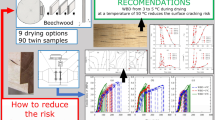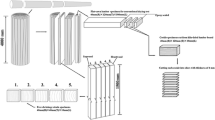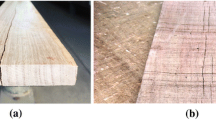Abstract
In the first part of this paper, a model of moisture movement and strain development for a sapwood board being dried under high-temperature conditions was developed. In this second part of the set, the stress development inside the board is examined. It is postulated that the stresses of the board must satisfy both the force equilibrium and geometric compatibility condition over the cross-section. Thus, as the evaporative front recedes into the board, significant tensile stresses will be successively induced at these locations, which are subject to the relaxation of the mechano-sorptive and creep strains. During the first drying period, it is found that the mechano-sorptive strain will have a principal influence on the magnitude of stress, whereas the creep strain can cause the large tensile stress falling significantly just after it has reached the peak value. After that, the relief effects of mechano-sorptive and creep strains tend to become much weaker. Because of the enhanced creep and softened material behaviour, wood subject to high temperatures may not necessarily lead to excessive degrade. It is demonstrated that the present model is capable of describing all the important drying phenomena observed in practice, including case-hardening (plastic set) and stress reversal. By accounting for the relief effect of mechano-sorptive and creep strains, a smaller board total shrinkage is obtained than that of a pure elasto-plastic model ignoring these stress-induced strains.
Zusammenfassung
Im ersten Teil war ein Modell der Feuchtebewegung und Dehnung eines Splintholzbrettes bei Hochtemperaturtrocknung entwickelt worden. Im zweiten Teil wird die Spannungsentwicklung in Innern des Brettes untersucht. Es wird postuliert, daß diese Spannungen sowohl den Bedingungen des Kräftegleichgewichts als auch der geometrischen Kompatibilität über den Querschnitt genügen müssen. Wenn die Verdampfungsfront ins Innere des Brettes zurückweicht, entstehen hier demgemäß bedeutende Spannungen, die aus der Relaxation der mechanosorptiven und Kriechdehnungen folgen. Während der ersten Trocknungsperiode hat die mechano-sorptive Dehnung den Haupteinfluß auf die Spannung, während die Kriechdehnung starke Zugspannungen erst unmittelbar nach ihrem Maximum verursacht. Danach werden die Relaxationseffekte beider Dehnungsursachen zunehmend schwächer. Aufgrund des verstärkten Kriechens und der Erweichung des Materials führt das Trocknen bei hohen Temperaturen nicht notwendigerweise zu starkem Abbau. Es wird gezeigt, daß das entwickelte Modell alle in der Praxis beobachteten Trocknungsserscheinungen beschreiben kann, einschließlich Verschalung und Spannungswechsel. Unter Einbeziehen der Entlastungseffekte durch mechano-sorptive und Kriechdehnung ergibt sich eine geringere Gesamtschwindung des Brettes als aufgrund eines rein elasto-mechanischen Modells, das diese Spannungsdehungen nicht berücksichtigt.
Similar content being viewed by others
References
Chen, G.;Keey, R. B.;Walker, J. C. F. 1997: The drying stress and check development on high-temperature kiln seasoning of sap-woodPinus radiata boards, Part I: moisture movement and strain model. Holz Roh- Werkstoff 55: 59–64
Laytner, F. 1995: Tackling problem strains. New Zealand Forest Industries. 26(5):31–32.
Lessard, R. A.;Limbert, D. E.;Pokoski, J. L.;Hill, J. L. 1982: A stress model for lumber drying control. Journal of Dynamic Systems, Measurement and Control, ASME. 104:283–289
Walker, J. C. F. 1993: Primary wood processing: principles and practices. London: Chapman and Hall
Wu, Q.;Milota, M. R. 1994: Effect of creep and mechano-sorptive effect on stress development during drying. Drying Technol. 12(8):2057–2085.
Author information
Authors and Affiliations
Additional information
This work is supported by a research grant from the New Zealand Foundation for Research, Science and Technology (UOC Contact 501)
Rights and permissions
About this article
Cite this article
Chen, G., Keey, R.B. & Walker, J.C.F. The drying stress and check development on high-temperature kiln seasoning of sapwoodPinus radiata boards. Holz als Roh-und Werkstoff 55, 169–173 (1997). https://doi.org/10.1007/BF02990539
Issue Date:
DOI: https://doi.org/10.1007/BF02990539




